IDEX Online Research: US Retail Jewelry Prices Rose Just 0.5% in 2013
January 20, 14
(IDEX Online News) – There was another decline in retail jewelry prices in the United States in December following drops in October, September and November, while inflation at the supplier level showed a very slight decline. For 2013 as a whole, the average increase in retail jewelry prices was just 0.5 percent.
JCPI Declines Slightly in December
For December 2013, the Jewelry Consumer Price Index (JCPI) stood at 163.1 compared with 166.2 in November. Here’s what this means:
- Retail prices of jewelry dropped by 0.3 percent on a month-to-month basis: December 2013 versus November 2013.
- Retail jewelry prices decreased by 0.5 percent on a year-to-year basis: December 2013 versus December 2012.
The graph below shows the movements in the JCPI over the past two years, and in 2013 in particular it is clear that although there were rises in the late Spring through to the Summer months, retailers did not have the power over consumers to push through higher prices.
Indeed, the JCPI ended the year down on the start of 2013, at 163.1 compared with 166.7 in January.
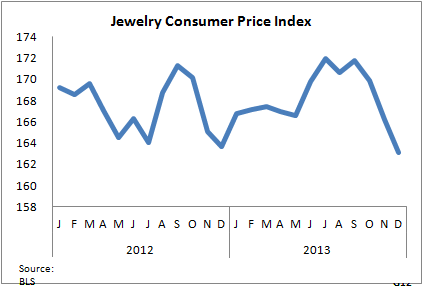
The decline over the past four months, and certainly for December, provides strong evidence that retailers were busy attempting to attract buyers by cutting prices and offering widespread discounts. Retail sales following the Christmas holiday sales season and reports from Main Street showed that this was indeed the case. Retailers appeared to be almost desperate to shift stock out of their stores as the new year and new styles approached.
The graph below gives an historical perspective relating to movements in the JCPI over the past three and a half years.
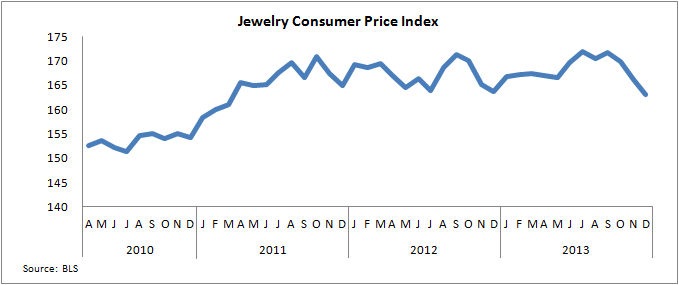
JPPI Stands Still in December
For December 2013, the Jewelry Producer Price Index (JPPI) came in at 211.5 compared with 211.9 for the month before – in other words, it was almost unchanged. Here’s what this means:
Wholesale jewelry prices largely stood still on a month-to-month basis: December 2013 versus November 2013.
Wholesale jewelry prices fell by a sharp 3.8 percent on a year-to-year comparison basis: December 2013 versus December 2012.
The graph below summarizes monthly JPPI over the past two years.
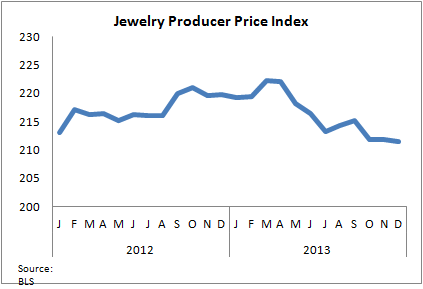
The main impetus, of course, for the fall in producer price inflation in 2013 was the decline in jewelry suppliers’ prices from 2012, as precious metals including gold, silver, and platinum, fell while polished diamonds largely stood still, though there were rises in certain goods, particularly smaller items.
Over the course of 2013, gold prices dropped by more than 20 percent and silver prices fell by in excess of 30 percent. As a result, it was clear that wholesale jewelry costs would fall on the year in 2013.
Looking forward, although the International Monetary Fund in January reported that the global economy would expand by 3.2 percent in 2014, jewelry price inflation is expected to remain moderate at most.
The graph below shows the interaction between supplier and retailer inflation over the past two years. The blue line represents retail prices of jewelry in the U.S. market while the red line represents wholesale prices.
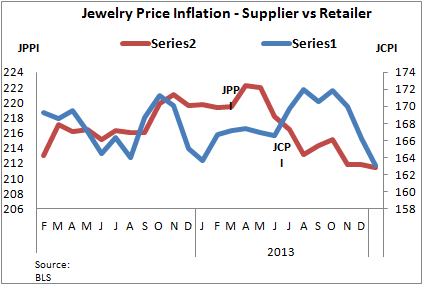
The graph below shows the decline in suppliers’ jewelry prices on a year-to-year basis. Suppliers’ prices have fallen consistently since July 2013.
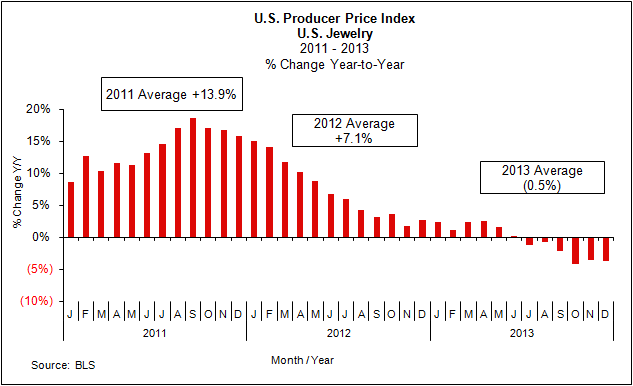
Meanwhile, the graph below shows the change in monthly retail jewelry prices on a year-to-year basis. Apart from a strong spike in the middle of the year, jewelry CPI was largely moderate throughout the year, with an average rise of 0.5 percent for the year.
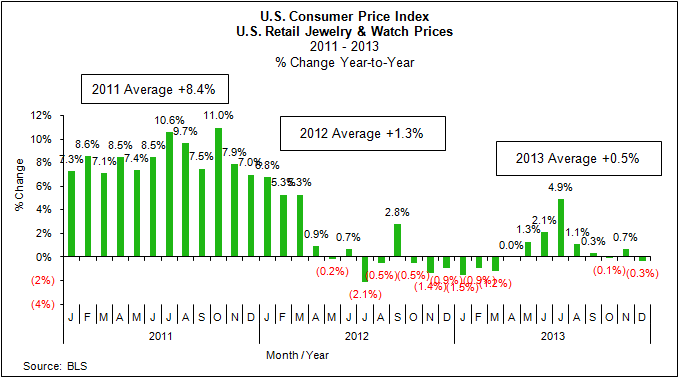
Meanwhile, this graph shows how low inflation was at stores in 2013 when compared with previous years. The 0.5 percent rise was considerably lower than in previous years, especially when compared with the years 2006-2008 and 2011.
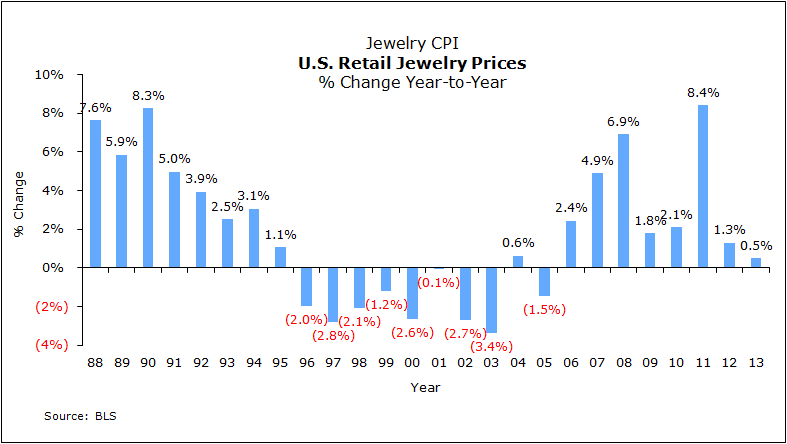
Inflation Likely To Remain Moderate
With the start of the New Year and with new collections in the stores as well as Valentine’s Day coming up, it can be expected that retailers will attempt to push up prices. Clearly the battle between consumers and retailers will continue, but if the trend of 2013 continues, store owners and chains will find that power still resides with shoppers.
Economic growth in the United States, despite a record year for leading stock exchanges and continuing rises in housing prices, remains constrained by high unemployment. Although the official jobless rate is 6.7 percent, many analysts and financial observers believe the true rate could be twice that figure when unemployed who no longer receive state of federal assistance and others who have given up looking for work are counted.
Without spreading wealth across large sections of the U.S. population, a large rise in jewelry sales cannot be expected. And even among those in work, the latest official figures show that the average hourly wage of U.S. employees rose just 0.2 percent in 2013. The U.S. is forecast to add at least two million jobs for the fourth straight year, pumping more money into the economy and moving it closer to its historical growth average of 3.3 percent. However, more than 20 million people looking for a solid full-time job still can’t find one, and that has pushed down salaries for most Americans overall.
Although some economists and President Barack Obama have stated that 2014 could be a “breakout year” with financial expansion finally due to take place, those predictions have been made in previous years, too, only to be proven to be false.